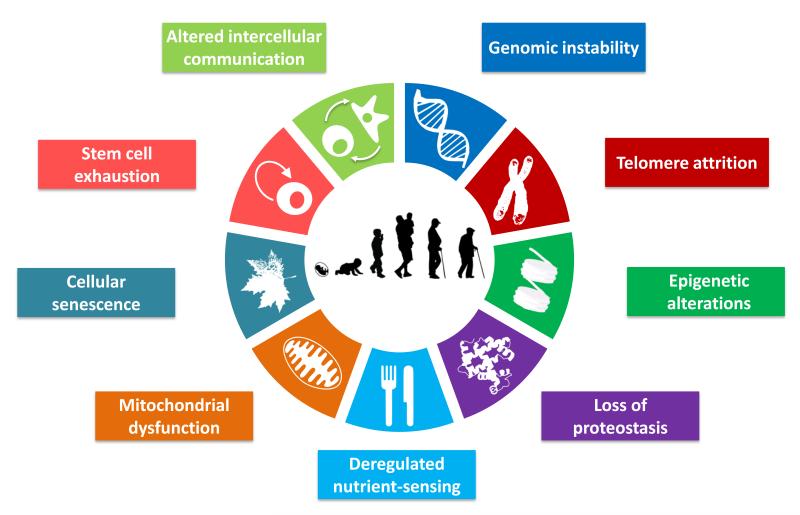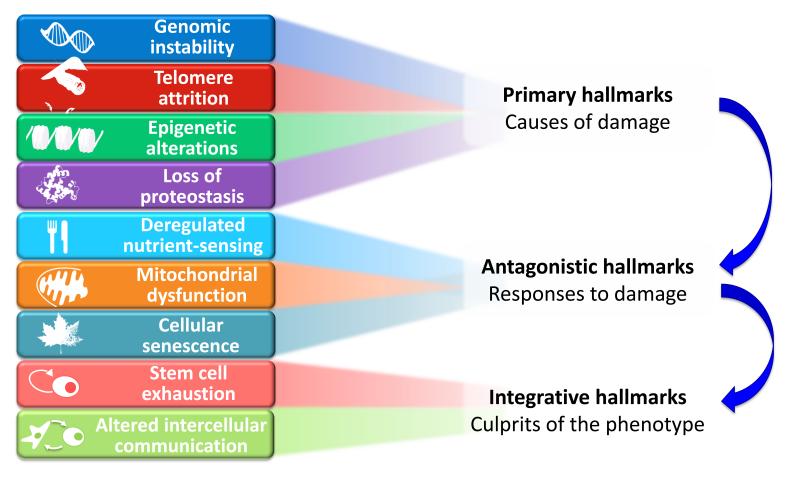Paper summary: The Hallmarks of Aging
This is a summary of the paper "The Hallmarks of Aging" [1][2], and my thoughts. The summary is biased by my interest and experience.
This paper is one of the most cited papers in aging biology, published in 2013. As I wrote on the past article https://junaruga.hatenablog.com/entry/2022/03/17/053422, the number of citation is 9228, at 16th March 2022 in Google Scholar.
Summary
The paper explains about 9 hallmarks of aging, and a possible intervention for each hallmark to improve the aging by the hallmark. It also suggests 3 kind of hallmarks, primary hallmarks, antagonistic hallmarks (a component can be good or bad by the threshold), integrative hallmarks. But there is a critique [3] about this.



9 hallmarks of aging
- Primary hallmarks
- 1: Genomic Instability
- A common factor of aging is the accumulation of genetic damage.
- The damage can happen in nuclear DNA, mitochondrial DNA (mtDNA), nuclear architecture (nuclear lamina).
- The damage has 2 types: 1. exognous damage (outside) such as chemicals, UV/IR radiation, 2. endogenous damage (inside) such as ROS, replication errors, spontaneous reactions.
- Interventions: Elimination of damaged cells
- 2: Telomere attrition
- Telomerase is an enzyme. If telomerase is activated, the telomere length becomes long. If telomerase is deactivated, the telomere length becomes short.
- Interventions: Telomerase reactivation
- 3: Epigenetic alterations
- The epigenetic changes can happen as DNA methylation, histone modification and chromatin remodeling.
- Interventions: Epigenetic drugs
- 4: Loss of proteostasis
- A folded protein could unfold by both exognous (outside) and endogenous (inside) stress. The unfold protein is 1. moved to lysosome by autophagy or 2. degradated or 3. refolded or 4. aggregated. The result 4 causes aging.
- Interventions: Activation of chaperones and proteolytic systems
- 1: Genomic Instability
- Antagonistic hallmarks
- 5: Deregulated nutrient sensing
- The growth hormone (GH), produced by the anterior pituitary, and the insulin-like growth factor (IGF-1), produced in response to GH causes aging. IGF-1 affected by dietary restriction (DR).
- Interventions: Dietary restriction: IIS (insulin and IGF-1 signaling) and mTOR (mammalian target of rapamycin) inhibition, AMPK (AMP (Adenosine monophosphate) -activated protein kinase) and sirtuin activation
- 6: Mitochondrial dysfunction
- Mitochondrial dysfunction by some factors causes aging.
- Interventions: Mitohormetics, mitophagy
- 7: Cellular senescence
- Cellular senescence is in young organisms, it's good to prevent the increased damaged cells (= anti-cancer) and anti-aging. However in old organisms, it's good to prevent the increased damaged cells (= anti-cancer), but contributes to aging.
- Interventions: Clearance of senescent cells
- 5: Deregulated nutrient sensing
- Integrative hallmarks
- 8: Stem cell exhaustion
- Interventions: Stem-cell-based therapies
- 9: Altered intercellular communication
- Interventions: Anti-inflammatory drugs, Blood-borne rejuvenation factors
- 8: Stem cell exhaustion
Pictures on [2] is summary for the 9 hallmarks, and picture for each hallmark (1 picture for 1 or 2 hallmarks), and intervention for each hallmark.
My thoughts
What I am the most interested in is 5. Deregulated nutrient sensing. Especially about GH, IGF-1, DR. It says decreased 'insulin and IGF-1 signaling' (IIS) extends longevity. Insulin is produced to reduce sugar level in blood when sugar intake happens. I am practicing ketogenic diet. That is to eat fat, protein, and vegetables and etc. But no sugar, no carbs, and no starch, no foods including sugar. My assumption is maybe ketgenic diet extends longevity.
Some aging books I read, the mechanism of ketogenic diet is not explained and considered. Inflammation of organism is also a factor of aging. But an inflammation by gluten, casein, allergy is not explained in it. These tendencies depend on personal traits. My assumption is maybe that we can optimize food intakes to extend longevity by personal food diagnosis.
My interest is an area to combine aging, ketogenic diet and food allergy, and wheat (gluten), casein and cellular and mitochondrial damage. A practice to prevent cellular and mitochondrial damage, are explained in a book "Strong Head - Dave Asprey".
References
- [1] The Hallmarks of Aging, 2013, Carlos López-Otín: https://pubmed.ncbi.nlm.nih.gov/23746838/ - Click the "full text links"
- [2] The Hallmarks of Aging: the full text, https://www.ncbi.nlm.nih.gov/pmc/articles/PMC3836174/.
- [3] The hoverfly and the wasp: A critique of the hallmarks of aging as a paradigm, 2021: https://pubmed.ncbi.nlm.nih.gov/34271186/